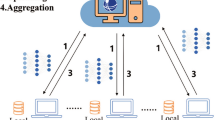Abstract
Insurance companies always use federated learning to integrate external data sources for data analysis and improve the conversion rate of insurance precision marketing. However, due to imbalanced data distribution and the presence of null data, the joint modeling often suffers from low robustness and is prone to falling into the dilemma of under-fitting. Therefore, the feature selection for federated learning needs to be incorporated before the joint modeling to improve the accuracy of predictions. In this paper, we propose the FedPV-FS method, which includes two-party feature selection based on public verifiable covert (PVC), and multi-party federated feature selection based on verifiable secret sharing (VSS). Moreover, we iteratively optimize federated feature selection using data selection, transformation, and integration. Experiments show that our method can achieve high-quality feature selection for increasing the optimization objective to 88.4%, promote the continuous increase of insurance premiums, and has good applications in insurance precision marketing scenarios.
Access this chapter
Tax calculation will be finalised at checkout
Purchases are for personal use only
Similar content being viewed by others
References
McMahan, H.B., Moore, E., Ramage, D., et al.: Communication-efficient learning of deep networks from decentralized data. In: Artificial Intelligence and Statistics, pp. 1273–1282. PMLR (2017)
Yang, Q., Liu, Y., Cheng, Y., et al.: Federated learning. Synth. Lect. Artif. Intell. Mach. Learn. 13(3), 1–207 (2019)
Wang, J., Zhang, A., Li, X., et al.: Efficient participant contribution evaluation for horizontal and vertical federated learning. In: 2022 IEEE 38th International Conference on Data Engineering (ICDE), pp. 911–923 (2022)
Chandrashekar, G., Sahin, F.: A survey on feature selection methods. Comput. Electr. Eng. 40(1), 16–28 (2014)
Pan, F., Meng, D., Zhang, Y., et al.: Secure federated feature selection for cross-feature federated learning (2020)
Yao, A.: Protocols for secure computations. In: 23rd Annual Symposium on Foundations of Computer Science, pp. 160–164. IEEE Computer Society, Chicago, Illinois, USA (1982)
Yang, Z., Sun, Q.: Joint think locally and globally: communication-efficient federated learning with feature-aligned filter selection. Comput. Commun. (2023)
Mahanipour, A., Khamfroush, H.: Wrapper-based federated feature selection for iot environments. In: 2023 International Conference on Computing, Networking and Communications (ICNC), Honolulu, HI, USA, pp. 214–219 (2023)
Chen, P., Du, X., Lu, Z., et al.: EVFL: an explainable vertical federated learning for data-oriented artificial intelligence systems. J. Syst. Archit. 126, 102474 (2022)
Feng, S.: Vertical federated learning-based feature selection with non-overlapping sample utilization. Expert Syst. Appl. (2022)
Li, A., Peng, H., Zhang, L., et al.: edSDG-FS: efficient and secure feature selection for vertical federated learning. In: IEEE International Conference on Computer Communication (2023)
Louizos, C., Welling, M., Kingma, D.: Learning sparse neural networks through l0 regularization. arXiv:1712.01312 (2018)
Hong, C., Katz, J., Kolesnikov, V., Lu, W., Wang, X.: Covert security with public verifiability: faster, leaner, and simpler. In: Ishai, Y., Rijmen, V. (eds.) EUROCRYPT 2019. LNCS, vol. 11478, pp. 97–121. Springer, Cham (2019). https://doi.org/10.1007/978-3-030-17659-4_4
Feldman, P.: A practical scheme for non-interactive verifiable secret sharing. In: 28th Annual Symposium on Foundations of Computer Science, Los Angeles, CA, USA, pp. 427–438 (1987)
Even, S., Goldreich, O., Lempel, A.: A randomized protocol for signing contracts. Commun. ACM, 637–647 (1985)
FATE Homepage. https://github.com/FederatedAI/FATE. Accessed 30 Nov 2023
J. Thomas. Mass spectrometric data. https://www.openml.org/d/41157
Dua, D., Graff, C.: UCI machine learning repository (2017)
Cheng, K., Fan, T., Jin, Y., et al.:SecureBoost: a lossless federated learning framework. arXiv (2019)
Chen, T., Guestrin, C.: XGBoost: a scalable tree boosting system. CoRR abs/1603.02754 (2016)
Author information
Authors and Affiliations
Corresponding author
Editor information
Editors and Affiliations
Rights and permissions
Copyright information
© 2024 IFIP International Federation for Information Processing
About this paper
Cite this paper
Wang, C., Feng, J. (2024). FedPV-FS: A Feature Selection Method for Federated Learning in Insurance Precision Marketing. In: Shi, Z., Torresen, J., Yang, S. (eds) Intelligent Information Processing XII. IIP 2024. IFIP Advances in Information and Communication Technology, vol 703. Springer, Cham. https://doi.org/10.1007/978-3-031-57808-3_31
Download citation
DOI: https://doi.org/10.1007/978-3-031-57808-3_31
Published:
Publisher Name: Springer, Cham
Print ISBN: 978-3-031-57807-6
Online ISBN: 978-3-031-57808-3
eBook Packages: Computer ScienceComputer Science (R0)





